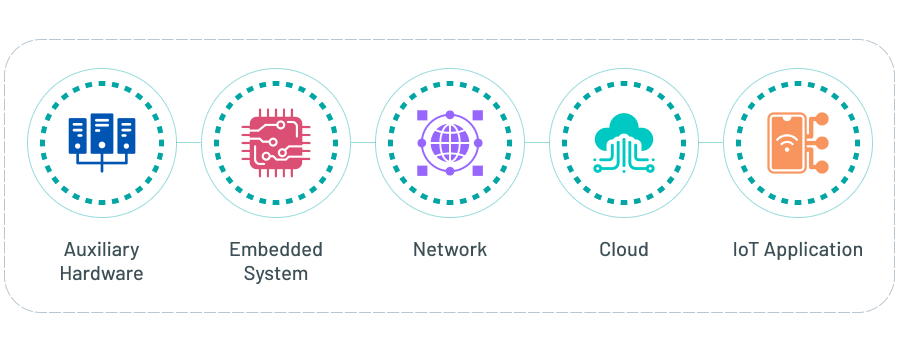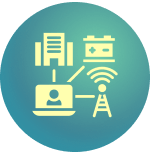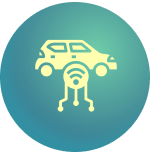The Internet of Things (IoT) has revolutionized the way we conduct business. It has become integral in various industries thanks to its ability to enhance efficiency, improve visibility, and reduce costs.
Yet, what made widespread IoT adoption possible? Well, everything began with embedded systems, and that’s precisely what we’d like to cover in today’s article. So, keep on reading to explore the world of IoT embedded systems and their impact on the different business sectors.
The Role of Embedded Systems in IoT

Before we discuss the various examples of how embedded systems and IoT work together across industries, let’s first decipher the difference between the two.
There are various types of embedded systems but all of them are basically a combination of computer hardware and software tools. More concretely, in this kind of a solution, hardware is embedded with a specific kind of software that will allow it to perform a concrete function. Typically, these systems can work independently or as part of a bigger platform, but each one will only ever be programmed to carry out a single task.
Learn about the Different Types of Embedded Systems
Conversely, IoT technology is essentially a network of connected devices that exchange data and communicate with each other through a network. These devices could be anything from smart home appliances to industrial machinery.
IoT can be used to connect and manage embedded systems, empowering your company to monitor assets remotely, control certain equipment, run timely data analytics, and basically automate multiple operational processes.
So, embedded systems and IoT are related concepts, but that doesn’t mean that the two terms should be used interchangeably because the former is rather considered as a subset of the latter. While an embedded system may not have internet connectivity, an IoT embedded system does.
Examples of IoT Embedded Systems
Now, let’s get a bit more specific. We’ve established the relationship between embedded systems and IoT projects, but it’s worth looking at concrete examples of these solutions across sectors. That way, you’ll be able to determine if your organization might benefit from the implementation of IoT-powered embedded systems.
Industrial IoT Devices

The industrial and manufacturing sector is possibly one of the primary ones for deploying IoT embedded systems. All because it consists of so many simultaneously moving parts, potentially dangerous environments, and remote locations that require monitoring.
Keep reading about the Powers of IoT in Manufacturing
Industrial IoT (IIoT) solutions can be truly wide-ranging. Various IIoT sensors, controllers, and devices can be used in manufacturing plants, oil rigs, and similar settings to monitor and manage operation processes from afar. Thus, optimizing efficiencies and improving safety procedures.
To give you a few concrete examples, embedded systems and IoT can work together to:
- Track asset location by getting data from GPS or RFID sensors
- Monitor equipment from afar by collecting pressure, temperature, and similar data
- Carry out predictive maintenance by anticipating machinery failure
- Control conditions under which products are transported
Our team has actually worked on a multitude of IIoT projects so if you’d like more examples, take a look at how we built an IIoT solution to manage anchor drives. Or, check out an exciting initiative that required cold chain monitoring system creation.
Wearable Devices

Of course, IoT embedded systems are present in more than just wearables in the healthcare context. In fact, there is an entire term for these kinds of smart solutions — Internet of Medical Things (IoMT). However, we’re discussing wearable technology today because it is one of the most prevalent examples.
Thanks to wearables, healthcare professionals can now monitor patients remotely, keep track of important health metrics, and provide real-time recommendations to clients. Thus, not only improving the quality of services they deliver but also boosting the overall patient wellbeing.
Learn more about IoT in Healthcare
Smart Vehicles

Smart vehicles are also a great example of using IoT embedded systems for truly mold-breaking innovations. Here, we aren’t just talking about autonomous cars, although they are indeed gaining a lot of traction in the world.
IoT embedded systems can also be employed in certain parts of vehicles like tires in order to help monitor temperature, air pressure, tread wear, and the like. Thus, keeping the driver informed of the state of each tire consistently.
Check out how we developed Next-Generation Smart Tires
Intelligent Retail

IoT embedded systems are typically used in retail solutions to track inventory, optimize supply chain management, create personalized shopping experiences, and even streamline the checkout process.
For example, with the help of computer vision, smart shelves, and intelligent sensors, grocery stores like Amazon Go allow customers to simply place items in their bag and leave the store without even pausing at the cashier’s desk. Instead, the right amount is simply charged to the customer’s Amazon account. Thus, significantly reducing wait times.
Additionally, IoT sensors can be used in retail stores or warehouses to monitor energy consumption levels. As you can imagine, this can help retailers identify areas where energy usage can be reduced. Naturally, this improves overall energy efficiency and reduces costs.
Smart Home Devices

Devices like smart thermostats, lighting systems, locks, and security cameras are some of the most popular in embedded systems and IoT-powered homes. They can be controlled through smartphones or even voice assistants and can automate various functions inside a house. All with the goal of providing great convenience, comfort, and safety.
For example, with the aid of smart locks and cameras, monitoring the house for unusual activity becomes seamless. Homeowners can control the devices remotely, and alerts can be triggered automatically if some sort of intrusion has been detected.
So, if you’re in the business of manufacturing appliances, definitely consider adding IoT embedded systems into your products. In the modern day, many consumers are interested in their powers.
Begin Your IT Journey
It is evident that IoT embedded systems can be game-changing for various business sectors. So, it’s a good idea to think about the implications of this technology for your company. After all, it will take some time to implement.
If you’d like some help with your next IT initiative, don’t hesitate to reach out to Velvetech. We consistently deliver efficient embedded systems development services to clients from a multitude of industries and would be happy to jump on board your project.









